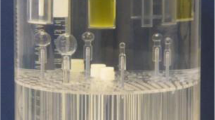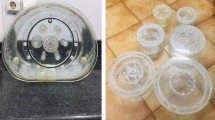Abstract
The aim of this study was to explore the correlations of detectability and the semi-quantification for hot spot imaging with positron emitters in positron emission tomography (PET) and with a positron coincidence detection system (PCD). Phantom study results for the measurement of the lesion-to-background (L/B) ratio ranged from 2.0 to 30.3, and detectability for hot spot lesion of PET and PCD were performed to correspond to clinical conditions. The detectability and semi-quantitative evaluation of hot spots from 4.4 mm to 36.9 mm in diameter were performed from the PET and PCD images. There were strong correlations between the L/B ratios derived from PET and PCD hot spot images and actual L/B ratios; but the L/B ratio derived from PET was higher than that from PCD with a significant difference of 10% to 54.8%. The detectability of hot spot imaging of PCD was lower than that of PET at 64.8% (PCD) versus 77.8% (PET). Even the actual L/B ratio was 8.0, hot spots more than 10.6 mm in diameter could be clearly identified with PCD imaging. The same identification could be achieved with PET imaging even when the actual L/B ratio was 4.0 This detailed investigation indicated that FDG PCD yielded results comparable to FDG PET on visual analysis and semi-quantitative analysis in detecting hot spots in phantoms, but semi-quantitative analysis of the L/B ratio with FDG PCD was inferior to that with FDG PET and the detectability of PCD in smaller hot spots was significantly poor.
Similar content being viewed by others
References
Strauss LG, Clorius JH, Schlag P, Lehner B, Kimmig B, Engenhart R, et al. Recurrence of colorectal tumors: PET evaluation.Radiology 1989; 170: 329–332.
Okada J, Yoshikawa K, Itami M, Imaseki K, Uno K, Kuyama J, et al. Positron emission tomography using fluorine-18-fluorodeoxyglucose in malignant lymphoma: a comparison with proliferative activity.J Nucl Med 1992; 33: 325–329.
Coleman RE. Revealing biochemistry in a single image.J Nucl Med 1995; 36 (9): 32N-33N.
Conti PS, Keppler JS, Halls JM. Positron emission tomography: a financial and operational analysis.AJR 1994; 162: 1279–1286.
Martin WH, Delbeke D, Patton JA, Hendrix B, Weinfeld Z, Ohana I, et al. FDG-SPECT: correlation with FDG-PET.J Nucl Med 1995; 36: 988–995.
Van Lingen A, Huijgens PC, Visser FC, Ossenkoppele GJ, Hoekstra OS, Martens HJ, et al. Performance characteristics of a 511-keV collimator for imaging positron emitters with a standard gamma-camera.Eur J Nucl Med 1992; 19: 315–321.
Drane WE, Abbott FD, Nicole MW, Mastin ST, Kuperus JH. Technology for FDG SPECT with a relatively inexpensive gamma camera. Work in progress.Radiology 1994; 191: 461–465.
Shreve PD, Steventon RS, Deters EC, Kison PV, Gross MD, Wahl RL. Oncologic diagnosis with 2-[fluorine-18]fluoro-2-deoxy-d-glucose imaging: dual-head coincidence gamma camera versus positron emission tomographic scanner.Radiology 1998; 207: 431–437.
Zhang H, Inoue T, Alyafei S, Tian M, Oriuchi N, Endo K. Tumor detectability in 2-dimensional and 3-dimensional positron emission tomography using SET-2400W: A phantom study.Nucl Med Commun 2001; 22: 305–314.
Lewellen TK, Miyaoka RS, Swan WL. PET imaging using dual-headed gamma cameras: an update.Nucl Med Commun 1999; 20: 5–12.
Tanaka G. Japanese Reference Man 1988. III: Masses of organs and tissues and other physical properties.Nippon Igaku Hoshasen Gakkai Zasshi 1988; 48: 509–513.
Kuhl DE, Wagner HN, Alavi A, Coleman RE, Gould KL, Larson SM, et al. Positron emission tomography (PET): clinical status in the United States in 1987.J Nucl Med 1988; 29: 1136–1143.
Al-Aish M, Coleman RE, Larson SM, Barrio J, Brodack J, Brooks D, et al. Advances in clinical imaging using positron emission tomography. September 14–16, 1988. National Cancer Institute Workshop Statement.Arch Intern Med 1990; 150: 735–739.
Conti PS, Lilien DL, Hawlay K, Keppler J, Grafton ST, Bading JR. PET and (18F)-FDG in oncology: a clinical uptake.Nucl Med Biol 1996; 23: 717–735.
Alyafei S, Inoue T, Zhang H, Oriuchi N, Koyama K, Endo K. Performance characteristics of PCD system in Axial filter (2D) and Open frame (3D) acquisition mode.KAKU IGAKU (Jpn J Nucl Med) 1999; 38: 615. (abstract)
Delbeke D, Patton JA, Martin WH, Sandler MP. FDG PET and dual-head gamma camera positron coincidence detection imaging of suspected malignancies and brain disorders.J Nucl Med 1999; 40: 110–117.
Author information
Authors and Affiliations
Corresponding author
Rights and permissions
About this article
Cite this article
Zhang, H., Inoue, T., Tian, M. et al. A basic study on lesion detectability for hot spot imaging of positron emitters with dedicated PET and positron coincidence gamma camera. Ann Nucl Med 15, 301–306 (2001). https://doi.org/10.1007/BF02987851
Received:
Accepted:
Issue Date:
DOI: https://doi.org/10.1007/BF02987851




